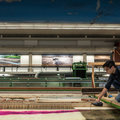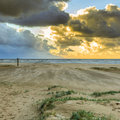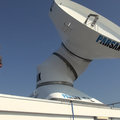News
14 December 2019
Mangroves caught in the middle

In a channel at TU Delft’s Water lab a stream of purple-tinted water makes its way past thousands of small wooden pegs. The water was dyed by PhD-candidate Son Truong Hong, who is closely observing the flow with an empty bottle of paint in his hands. This test forms part of his research into the importance of the mangrove forests in the Mekong Delta estuaries. Son is fascinated by the tangled roots of these extraordinary trees. What is the mangrove’s role in preventing river bank erosion? And, most crucially, how much of the mangrove forests needs to remain to support a healthy ecosystem?
10 December 2019
Greenland ice losses rising faster than expected

Greenland is losing ice seven times faster than in the 1990s and is tracking the IPCC’s high-end climate warming scenario, according to the Ice Sheet Mass Balance Inter-comparison Exercise (IMBIE) Team.
10 December 2019
Weather alarm: chance of sudden death

Rain radar, weather apps, satellite images and code yellow (weather warning code in NL): we are all fascinated by the weather. Nevertheless, even the experts know less about it all than we think, particularly when it comes to the weather at night and in cold areas. Bas van de Wiel wants to change that. He intends to use his ERC Consolidator Grant to give the underappreciated nights a bigger role in weather and climate models.
08 December 2019
Continuously scanning the coast

Hotel Atlantic in Kijkduin overlooks the North Sea. On its deserted roof a state of the art laser scanner is monitoring the beach every hour, 24/7. Sander Vos hopes the resulting data will provide insight into the restoration of the coast after a storm when part of the beach and fore dunes disappear into the sea. With the information provided by the scanner he and his TU Delft colleagues hope to become ‘coastal weathermen’ who will be able to predict exactly how the beach behaves after a storm.
06 December 2019
Observing rain at street-level

Heavy showers sweep over cities, flooding streets and houses when urban drainage systems get overwhelmed. Ever-increasing pressures from climate change, population growth and changes in land use augment the risks of urban floods. We’re currently unable to predict accurately where and when flooding will occur. Forecasting is particularly tricky in densely populated cities, where rainfall observations are scarce, spatial variability in land-cover is high and flood response to rainfall is very fast. Researchers want to use radar and innovative ground sensors to observe rainfall and water levels more accurately and at higher density to improve the reliability of hydrological predictions . Marie-Claire ten Veldhuis is trying to gather this information in various projects. Her objective is to unravel the complexity of urban hydrological response, to be able to predict with greater accuracy when and where streets will flood.